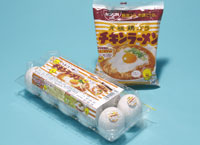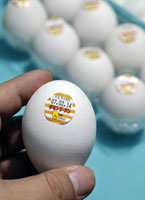|
|
|||||||
|
|
|||||||
|
|||||||
| | Web Japan >> | Trends in Japan >> | Business & Economy >> | Egg-Vertising | |
|
EGG-VERTISING First Ovular Ad Promotes Chicken Noodles (March 27, 2007) Eggs are being used as the latest innovative advertising medium. In February 2007 Japan got its first egg-based advertisement, with Nissin Food Products, the company that invented instant noodles, becoming the country's first "ovular advertiser." The ads, which tout Nissin's flagship chicken ramen, take the form of small stickers affixed to individual eggs, which are packaged and sold at about 200 stores of the Daiei supermarket chain. The company expects sales to total about 300,000 cartons a month and plans to conduct a campaign for chicken ramen while the ads run. The Egg Advantage Egg advertisements have already appeared in the United States and elsewhere, but in these countries the messages are applied directly to the eggshell using inkjet technology. In Japan, however, it was felt that consumers would be uncomfortable with this method, and the advertisements were instead put on stickers that could be affixed to individual eggs. Nissin's ad features the chicken ramen logo along with the egg's expiration date. The egg pack is wrapped in paper detailing tasty recipes that use chicken ramen and eggs, and the supermarkets where the eggs are sold display the noodles alongside them. The firm says the setup makes great business sense, because it provides a new place for selling its product away from the noodle aisle. Ads That Can Be Grasped, Literally Eggs have an added advantage as an advertising medium because they allow companies to reach a targeted audience and specific regions. An executive at a leading advertising firm comments, "New attention is being paid to advertising media that can actually be held, particularly at a time when Internet ads are on the rise." Copyright (c) 2007 Web Japan. Edited by Japan Echo Inc. based on domestic Japanese news sources. Articles presented here are offered for reference purposes and do not necessarily represent the policy or views of the Japanese Government. |
||
|




